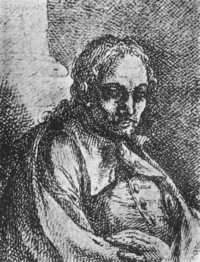Battistello Caracciolo facts for kids
Giovanni Battista Caracciolo (1578–1635), also known as Battistello, was an important Italian painter. He lived in Naples and was a big follower of the famous artist Caravaggio.
Contents
Early Life and Family
Battistello Caracciolo was born in Naples, Italy, on December 7, 1578. His parents were Cesare and Elena Caracciolo. The family lived in the area of San Giovanni Maggiore.
When he was 20 years old, on August 3, 1598, Caracciolo married Beatrice de Mario. They had ten children together. Eight of their children grew up to be adults.
Learning to Paint and Caravaggio's Influence

Battistello first learned to paint from artists like Francesco Imparato and Fabrizio Santafede. But the biggest change in his art happened when Caravaggio came to Naples. Caravaggio stayed in Naples for about eight months in 1606 and again briefly in 1609. His unique style had a huge impact on all the artists there.
Caracciolo was only five years younger than Caravaggio. He quickly started using Caravaggio's new and exciting painting style. This style used dark colors and strong contrasts of light and shadow, called tenebrism. The figures in the paintings looked very real and almost popped out of the canvas. Caracciolo is seen as the main artist who started the "Caravaggism" style in Naples. Other artists who followed this style included Giuseppe Ribera and Artemisia Gentileschi.
Battistello's early work was very much like Caravaggio's. For example, his painting The Crucifixion of Christ looks a lot like Caravaggio's Crucifixion of Saint Andrew. In 1607, he painted Immaculate Conception for a church in Naples. This was one of his first paintings in the Caravaggio style.
Later Travels and New Styles
In 1612, Battistello traveled to Rome. There, he saw the work of other artists like Orazio Gentileschi. You can see this influence in his painting Liberation of Saint Peter (1615). This painting was made for the same church that held Caravaggio's famous Seven Works of Mercy. By this time, Caracciolo was a leading artist in Naples. He painted religious scenes for churches and also made paintings for private collectors.
After 1618, he visited other cities like Genoa and Florence. In Rome, he learned about a different style of painting from the Carracci family. This style, called Classicism, focused on balance and clear forms. Caracciolo started to mix this new style with his own use of strong light and shadow. His painting Cupid shows how he combined these ideas.
When he returned to Naples, he used these new ideas in his large fresco paintings. Frescos are paintings done directly on walls or ceilings. His masterpiece, Christ Washing the Feet of the Disciples (1622), is a great example. He painted many other works in churches around Naples. These later works show how much he was influenced by the Classicism style he saw in Rome.
Battistello Caracciolo passed away in Naples in December 1635.
Gallery
-
Christ and Caiaphas
See also
 In Spanish: Giovanni Battista Caracciolo para niños
In Spanish: Giovanni Battista Caracciolo para niños










